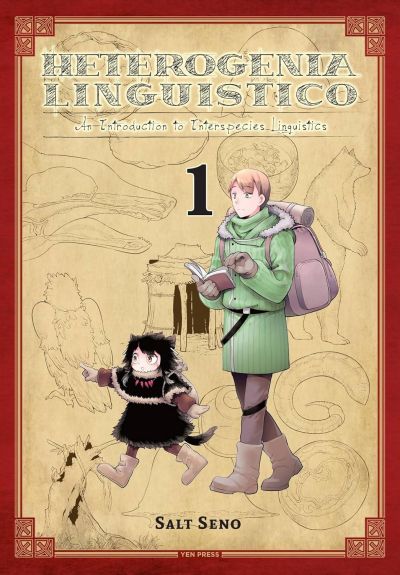Listen Carefully
An Introduction to Interspecies Linguistics (Heterogenia Linguistico, volume 1)
By Salt Seno (Translated by Amanda Haley)

24 Jul, 2024
Heterogenia Linguistico, Volume 1: An Introduction to Interspecies Linguistics is the first tankōbon for Salt Seno’s secondary-world comparative-linguistics manga. Serialized in Young Ace Up since 2018, the 2020 English translation is by Amanda Haley.
When his mentor is injured, Hakaba is dispatched to take the old linguist’s place. The subject matter — comparative linguistics — is straightforward. It is the location that might give some qualms: the Netherworld, land of monsters!
Hakaba’s jovial teacher believes in encouraging curiosity and diligence. Thus, the old fellow keeps to himself certain aspects of his research, so as to avoid biasing Hakaba’s results. Hakaba discovers one such non-disclosure as soon as he makes contact with the werewolves: humans and werewolves1 are interfertile2, and his professor’s half-human, half-werewolf daughter Susuki will be Hakaba’s guide.
Aside from their lupine heads, the werewolves look similar to humans. The werewolves strike the linguist as taciturn. Hakaba discovers that appearances are misleading. Werewolves have superlative powers of smell. Scents of which Hakaba is unaware are a key part of werewolf communication. The werewolves are not uncommunicative at all.
This sets the standard for the Netherworld. Some monsters, such as lizardmen, are almost as human-appearing as the werewolves. Others, like the kraken, blobs, and the harpies, look very different indeed. Each has their own particular suite of senses, some senses more acute than human, others less. All of these have shaped each monster race’s language.
The denizens of the Netherworld are used to being surrounded by persons whose bodies are as different from theirs as their cultures are divergent. The Netherworlders have embraced many customs to facilitate co-existence. Can Habaka adapt, or are his studies doomed by human inflexibility?
~oOo~
A better question might be “are the monsters doomed by human inflexibility?” A fact mentioned in passing is that first contact between monsters and humans involved the humans screaming in terror before fleeing. What happens when Habaka reports back that the fearsome-looking demihumans are peaceful, not warlike or anthropophagous at all3?
Heterogenia Linguistico’s focus is field research. There are not, at least in volume one, any efforts to dramatize events with impending military or political crises. Instead, Hakaba wanders around with his werewolf guide, encountering various nonhumans while trying to make sense out of what he experiences.
Salt has clearly put in a lot of thought into imagining how anatomy and ecological niche might shape language, and how beings might bridge the potential communication gaps between them. Happily, Salt’s art is up to the task of conveying their setting. While the world may or may not be fantastic, the manga itself is clearly hard science fiction and the science is linguistics.
The result is an amiable but highly entertaining manga. I don’t think it lends itself to further reviews (although I could be wrong) but it’s definitely a work I intend to archive binge. You should too.
Heterogenia Linguistico, Volume 1 is available here (Amazon US), here (Amazon Canada), here (Amazon UK), here (Apple Books), here (Barnes & Noble), here (Chapters-Indigo), and here (Words Worth Books).
1: Despite the name, the werewolves are not shape shifters. They’re full-time wolf-headed people. Susuki appears almost human, save for wolf ears.
2: Habaka has questions that he concludes are best not to pursue.
3: Leaving aside certain funerary practices involving eating the dead.
